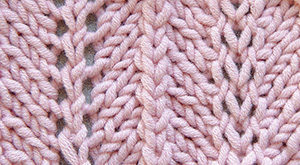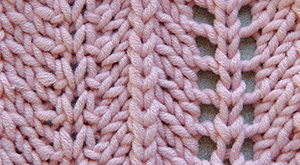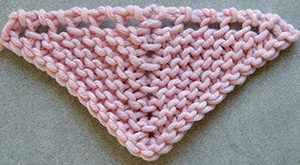In knitting, increases and decreases are fairly simple. Double increases add stitches and decreases take them away. They enable us to knit beyond simple rectangles. With increases and decreases, we can knit sweaters and socks, hats and even fun stuffed animals, like hedgehogs. The appearance of increases and decreases help to create a stitch pattern’s distinctive look. Using double increases you create three stitches where only one existed before.
Two singles make a double knitting stitch
To knit a double increase, you simply put a single increase on either side of a center stitch. On the right of the Photo 1 swatch is a knit stitch with a M1L and M1R on either side of it. This double increase (M1L, k1, M1R) is subtly blends with the rest of the knit stitches. On the left side of the Photo 1 swatch is a less-subtle variation of the double increase made by knitting the M1L through the front loop and the M1R through the back loop. This reversal of the normal double increase method leaves the new stitches open, appearing as small eyelets (open M1L, k1, M1R).
You can knit even larger eyelets by working yarn over increases on either side of a center stitch. Pairs of yarn overs are common in lace knitting patterns. An “OKO” (yarn over, k1, yarn over) double increase is shown on the right side of the Photo 2 swatch.
So far, all of the increases we’ve covered are created between stitches. You can also use the “k1f&b” (knit 1 front and back) single increase to create a double increase, but because it uses a single stitch to create two, you must place it in a slightly different way. Work the k1f&b by knitting into the front, and then again into the back of a single stitch, before sliding the old stitch off the left needle. You’ll see that the new left stitch has a little purl-like bump at its base. To create a knit center stitch with two purl-like bumps on either side, you must work the first k1f&b in the stitch before the center stitch, and the second k1f&b in the center stitch. The left side of the Photo 2 swatch shows the result.
True double knitting increases
Create a true three-from-one double increase by extending the k1f&b increase: Knit into the front of a stitch, then its back, and then the front again. The end result is not always worth the tight maneuvering required to work this increase: The two added stitches both appear to the left of the original stitch in a little clump with a hole below it. A true double increase is appropriate when adding stitches to create a bobble, which is at least a visually interesting clump of stitches.
The “KOK” (k1, yarn over, k1) increase is easier to work and looks better, as shown in Photo 3. As with the k1f&b increase, you work multiple times into the same stitch, but instead of knitting into the back, a yarn over is worked. Knit into a stitch, but don’t slide the old stitch off the left needle; bring the working yarn to the front between the needles and over the right needle; insert the right knitting needle back into the original stitch, wrap and pull through; slide the whole mess off the left needle. The original stitch will be stretched by its children, appearing as a single eyelet. This technique is used in the center back of the Double-Increase Shawl pattern.
Double your knitting fun
A simple, knitted shawl begins with one stitch and increases one stitch at the beginning of each row (or at each end of every other row). By knitting every row, and combining the garter stitch with rate of increases, you’ll create a triangular, knitted shawl that’s the perfect size for draping around your body. This shawl has horizontal lines but and rows of purl bumps and knit valleys.
By putting two of these horizontal triangles side by side, you can create the same larger triangular shape but with more flattering diagonal lines. The two singles we just put side by side are effectively one double increase. You can see this in the line of purl stitches on the third swatch (Photo 3).
We’ve looked at several ways of knitting double increases. Now that you understand them, you can switch the M1s used in your top-down raglan pattern for the more decorative open M1s or create your own stitch pattern by using 2 k1f&bs instead of 1 KOK.
by Beth Whiteside









